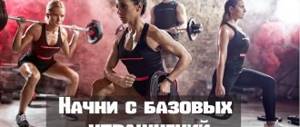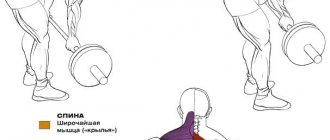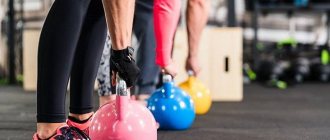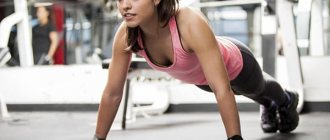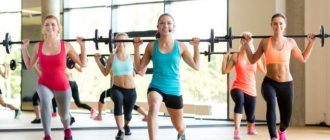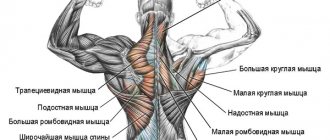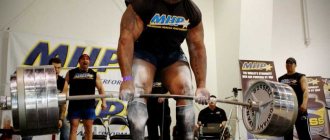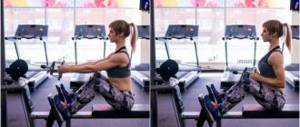Features of the exercise
The peculiarity of the exercise and the difference, for example, from a barbell deadlift is the fixation of one end of the bar. As a result, there is no need to control the trajectory of the bar and only the back muscles are involved in the work, excluding the work of the stabilizer muscles. There are several simulators for performing the element, allowing you to work from a lying or standing position. In the absence of the latter, you can connect a regular rod to the work.
The bent-over row of a barbell or barbell consists of the fact that one end of the barbell is attached to the floor and rests against something hard, and weights from the barbell are placed on the other side of the equipment. You will also need a V-shaped handle from a pulley machine for horizontal rows. The load when performing the element can be changed: you can focus on working both the upper back and the lower part of the latissimus muscles. To do this, the direction of the pull to the body changes: it can be a pull to the chest or to the belt.
Execution Sequence
- Approach the apparatus, bend over, grab the bar with your hands with a comfortable grip
- bend your knees slightly, move your buttocks back, take a breath into your lungs
- Slowly begin to pull the t-riff towards your chest while exhaling.
- At the top point of the amplitude, hold for a second, contract your back muscles
- Smoothly lower the t-bar down without straightening your elbows to the end
- Pause at the bottom for a second to stretch your back muscles.
- Complete the required number of repetitions
Position No. 1
Position 2
T-bar or bent-over barbell row?
We have already said above how the classic barbell row differs from the bent-over T-bar row - it is a fixed amplitude of movement. Accordingly, the barbell row is more difficult to perform, it involves stabilizer muscles, you cannot lift a lot of weight, it is suitable for advanced athletes and athletes.
For beginners, our t-bar row becomes an alternative, both easier from a technical point of view and with setting goals - gaining muscle mass. After all, if you take more weight into the T-bar rows, hypertrophy will be many times higher. Therefore, we advise beginners to start with the T-bar in order to hone their technique. In terms of effectiveness, the exercises are very similar, and it is very difficult to single out one of them.
Benefits of the T-Bar Row
The bent-over T-bar row is a very useful element of training for any athlete who wants to have a proportionally and beautifully pumped up body. The benefits of deadlifts are primarily related to a strong back. Only with a strong back can you begin any strength training with weights. In addition to this training:
- Allows you to work different muscles and areas of the back due to the possibility of different grips on the machine.
- Pumps up the large back muscles in the area of the shoulder blades, making the back wider.
- Makes the figure athletic by giving a relief contour to the middle section of the trapezius muscles.
- In addition to the back muscles, it includes the abdominal press.
- Keeps your back muscles toned and promotes the formation of beautiful posture.
There are also contraindications for performing the element. Since when performing the exercise there is an axial load on the spine, it should not be done by persons with hernias, protrusions or degenerative changes in the spine. The only modification of the element is possible: traction of the bar with emphasis on the bench, at which the axial load is minimal.
Contraindications for implementation
This exercise is not without axial load on the spine, therefore, if there are hernias, protrusions or degenerative changes in the spine, it is strictly prohibited to perform it. The alternative suggests itself: T-bar rows with emphasis on the bench. In this exercise, axial load is kept to a minimum. In addition, movement at a given amplitude practically does not give you the opportunity to use cheating, therefore you will not overload the spinal extensors.
If your gym does not have such a machine, use a regular bench, set the incline to 30-45 degrees and perform barbell or dumbbell rows on it. The movement will be almost completely isolated, and the latissimus dorsi muscles will work completely differently. Another option is to do horizontal rows on lever or cable machines with light weights. This load will be quite enough to make your back bigger and stronger.
What muscles work?
So, in order to perform the exercise as efficiently and correctly as possible, let’s take a closer look at which muscles work during the bent-over barbell row.
First of all, these are the following back muscles:
- lats;
- large round;
- diamond-shaped;
- long extensors of the spine;
- trapezoidal;
- posterior deltoid bundle.
In addition, the hips, abs and forearms work statically.
Execution technique
The technique for performing bent-over t-bar rows is as follows:
- We take a barbell and install the required number of weights on one end. We fix the other end of the equipment in a corner or rest it against something solid on the floor. We attach a handle from a horizontal row machine to the bar next to the weights. In the absence of the latter, we take the bar with both hands closer to the pancakes. In this case, we place one hand a little closer to the pancakes, and the other a little further. After each approach, the position of the hands must be changed.
- Place the barbell between your legs with your knees slightly bent. We bend over, keeping our back straight with a natural arch in the lower back. We tense the muscles of our legs and abs and take the end of the reef in our hands. We direct our gaze forward.
- We pull the barbell towards ourselves, exhaling. The latissimus dorsi muscles should work. We linger at the top point for a few seconds, while bringing our shoulder blades together. The contraction of the back muscles should be felt.
- Slowly lower the barbell while inhaling to its original position. At the same time, the muscles relax, the elbows do not fully extend, and the pancakes do not touch the floor.
- We do three sets of 10-12 repetitions.
Important! When performing the element, monitor the work of your back muscles. The legs should only accept static load. Control over the trajectory of the elbows is also necessary: they should always be close to the body.
Exercise options
Before you start training, you need to decide on the load, depending on what part of your back you are going to train. In accordance with this, the following variants of the element are distinguished:
Bent-over bar row to chest
This version of the bent-over T-bar row is used when it is necessary to emphasize the load on the upper back. In this case, you just need to stand away from the part of the bar on which the weights are attached. At the same time, try to calculate as accurately as possible the distance at which you should stand, otherwise you risk receiving a careless blow to the head when you jerk the bar sharply.
Bent-over row of the bar to the belt
This type of exercise is used to pump the lower part of the latissimus dorsi muscles. Here you should take a position as close as possible to the edge of the simulator, i.e. to the end of the bar with attached weights.
The grip is also of great importance. The wider it is, the stronger the teres minor and major muscles will work. Parallel and close grips engage the latissimus dorsi muscles more. A reverse grip will allow you to work deeper on the lower part of the latissimus muscles, connecting the biceps to the work.
Simple and effective back workout
Deadlifts in this workout always come before bent-over rows.
This is because the deadlift involves using more muscles. It is technically more challenging and allows for heavier weights to be lifted, making it more taxing than any bent over row variation. Therefore, in any case, it is advisable to do the deadlift first, when you are still physically and mentally fresh. Then, as a rule, perform the second most difficult exercise (often another basic one), and then any other less difficult ones. Workout : Deadlift .
After warm-up sets:
- For experienced athletes (men): 3 sets of 4-6 reps at 80-85% of one-repetition maximum (1RM).
- For women and beginners: 3 sets of 8-10 reps at 70-75% of 1RM.
Bent-over barbell row: 3 approaches:
- 4-6 repetitions (experienced athletes - men).
- 8-10 reps for women and beginners.
Wide grip lat pulldown: 3 sets:
- 4-6 reps for experienced male athletes.
- 8-10 reps for women and beginners.
Optional (optional): Bent-over T-bar row:
- 3 sets of 8-10 reps.
Now a little about how to carry out this training.
- Don't aim for muscle failure on every set . Muscle failure is the point at which you can no longer hold the weight in motion and are forced to finish the set (from fatigue). It is necessary to complete the exercise shortly before failure (1-2 repetitions). And it is very rare to do “refusal” approaches. Most competent athletes do not train to muscle failure for more than 2-3 sets per workout. And they try not to reach this state when performing basic exercises, as this can be dangerous. Instead, “failure” approaches are reserved for isolation exercises, such as: lying leg curls, seated leg extensions, calf raises, and the like. This is how load progression is achieved.
- Rest 3-4 minutes between sets . This will give the muscles enough time to fully regain strength so that you can fully perform each set.
- As you reach your maximum reps, increase the weight on the bar . For example, if you did 6 reps with 75 kg on the first set, add 5 kg to the barbell for the next set. If at the same time you managed to do 4 repetitions, then this will be your new weight for training until you reach 6 repetitions again. And when you reach 6, increase the weight again. If you get 3 or fewer repetitions, then try removing not all 5 kg, but 2 or 3 kg. Alternatively, train with the same weight you trained with until you can do 6 reps for all sets, and then increase the weight again. If you have difficulties again, try, if possible, to add as little weight as possible to the bar.
That's all!
Have fun training! Good luck!
Recommendations for performing the exercise
In order for the exercise to bring the best results and not lead to possible injuries, you must adhere to the following recommendations:
- Correct starting position . Particular attention should be paid to the angle of inclination. The smaller it is, the greater the load on the lower lats. As the angle of inclination approaches straight, the upper back will be worked out more strongly. Whatever angle of inclination you choose, you must keep your back straight with a natural arch in the spine.
- Choice of weights . Don't overload yourself: start with light weights and gradually increase the load. For heavy weights, you can use an athletic belt. But remember that it makes it difficult to keep your back straight and prevents proper breathing. Choose plates with a smaller diameter: large plates interfere with your grip and reduce the range of motion.
- Control over technology . Make sure that while performing the element, you work your back, not your biceps. Watch your elbows and the position of your back: the first should always be closer to the body, and the second should remain straight at each point in the execution of the element.
- Tempo . Choose the most comfortable pace for the exercise. Avoid jerking, all movements should be smooth: slowly lower the bar and quickly raise it.
How to lose weight in the stomach and not pump over the muscles?
As much as we might want it, working out your abs won't help you burn belly and flank fat. That is, if you are overweight, you will certainly tighten and strengthen your figure, but relief will not appear until the amount of fat in the body changes.
Regarding weight loss, there is a golden rule - you need to consume less than you receive. That is, in order to achieve the goal you need to either reduce your diet, or increase physical activity, or all together. And then the magnificent relief of the sides and six-pack abs will not take long to appear. Intensive twisting, by the way, entails significant energy consumption.
The second fact concerns pumping up the oblique muscles and, accordingly, saying goodbye to the dream of a narrow waist. For most people, abdominal exercises are recommended to be performed without additional weights and in a large number of repetitions. This also applies to Russian twists.
Of course, for more intensive muscle training, you can use a small small plate or weights, but this should only be done if your goal is not to narrow your waist, but to increase the volume of your muscles to enhance their definition. Below we will show variations of Russian crunches without additional weight and with the use of weights. So there is enough exercise for everyone!

